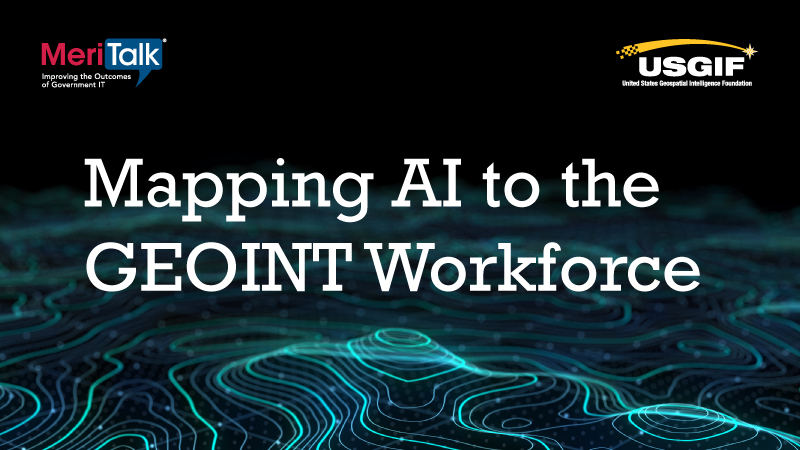
The geospatial intelligence (GEOINT) industry and workforce is undergoing a seismic shift driven by artificial intelligence (AI), with 91 percent of stakeholders believing AI has the potential to greatly improve GEOINT productivity, capacity, and capability. That potential impact, however, appears to be racing ahead of on-the-ground planning as just 33 percent of GEOINT stakeholders report having a clear AI workforce strategy.
Today, MeriTalk released the “Mapping AI to the GEOINT Workforce” report in collaboration with the United States Geospatial Intelligence Foundation (USGIF). The report – underwritten by Intel, MFGS, Inc., Microsoft, and Recorded Future – reveals both the opportunities and challenges AI presents across Federal, state, local, and higher education landscapes.
“With AI being just announced by NGA as one of the five Tech Areas, this is a very timely study that will help inform the future of our work. Embracing the third wave of AI, USGIF and its partner academic institutions have been incorporating data mining, analysis, fusion and processing into their curricula in addition to the already taught GIS, Remote Sensing and Data Visualization competencies,” said Dr. Camelia Kantor, Vice President of Academic Affairs, USGIF.
Recognizing the Roadblock: Skills
The research report’s findings come from MeriTalk’s survey of 150 Federal, state and local (SLG), and higher education GEOINT stakeholders. While respondents agree that human-machine teaming will be the industry’s new normal within just five years, the GEOINT workforce has half (or fewer) of the skills needed to actualize AI benefits.
Steve O’Keeffe, founder of MeriTalk, commented, “If you’re not hip to AI, you’re DOA in GEOINT. We can choose to ride the new wave, or get drowned by it. Good time to learn to swim.”
The report identifies significant hurdles standing in the way of organizations fully capitalizing on AI in the workforce:
- The majority (57 percent) say addressing the skills gap will be their biggest challenge over the next decade;
- Fifty-one percent say security concerns will be a complication; and
- Less than half (41 percent) say lack of funding is a concern as stakeholders prepare to accelerate AI technology
Waking up the Workforce
Organizations are beginning to recognize the importance of implementing a formal AI workforce strategy. Just one-third of respondents report having a strategy in place today. However, 54 percent share that they are working on one. Size appears to matter, as Feds are significantly more likely to have a formal strategy (46 percent) compared to SLG (23 percent).
Additionally, organizations are investing in the workforce – skills development, training, hiring, and more. Higher education organizations (76 percent) are currently investing in AI skills, at about the same rate as Fed (73 percent), and outpacing SLG (53 percent).
These investments are essential to maximize AI potential. Stakeholders predict that GEOINT-related AI will have the greatest impact on national security, emergency response and natural disaster aid, and urban planning and development.
Plotting the Future of AI
Looking ahead over the next 12-18 months, 42 percent of respondents say they will prioritize data visualization and data mining, analysis, fusion, and processing. In addition, 46 percent say predictive modeling will be priority.
GEOINT stakeholders envision an AI-ready workforce that’s collaborative, data-driven, and diverse in the next 10 years.
To realize this vision, the report suggests GEOINT leaders increase collaboration with universities on AI curriculum, and work to integrate AI skills into new and existing workforce training.
For more information view the full report.
MeriTalk’s Director of Research will host expert panelists from government, industry, and academia during a virtual panel on the research results on Wednesday, May 27. Register for the virtual event.
